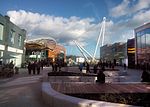National Cycle Route 88

National Cycle Route 88 (or NCR 88) is a route of the National Cycle Network, running from Newport to its planned finish site at Margam.The full route planned will pass along the coast of South Wales, largely east–west from Newport to Cardiff and on to Margam via Bridgend, and in total may go on to stretch for 78 km (48 mi) in length. The route is so far formed by a mixture of some new paths, such as a boardwalk made of recycled material around Caerleon, stone paths through Newport city centre, and in other places public highways. On some linked paths such as canal paths, a hybrid or 'hard tail' mountain bike fitted with wide road tyres would be most suitable. Newport city centre and Cardiff are both easily reached on the rail network. Typically South Wales is more accessible through the canal paths heading up north into the valleys than east to west.
Excerpt from the Wikipedia article National Cycle Route 88 (License: CC BY-SA 3.0, Authors, Images).National Cycle Route 88
Kutaisi Walk, Newport Stow Hill
Geographical coordinates (GPS) Address Nearby Places Show on map
Geographical coordinates (GPS)
| Latitude | Longitude |
|---|---|
| N 51.58663 ° | E -2.991209 ° |
Address
Kutaisi Walk
Kutaisi Walk
NP20 1HG Newport, Stow Hill
Wales, United Kingdom
Open on Google Maps










